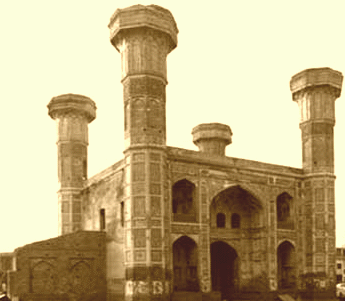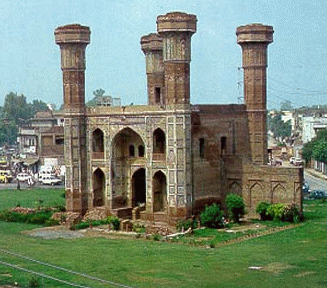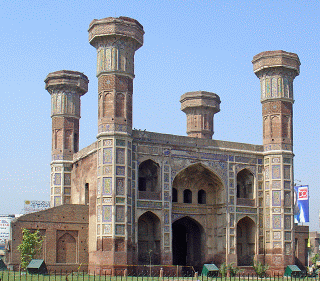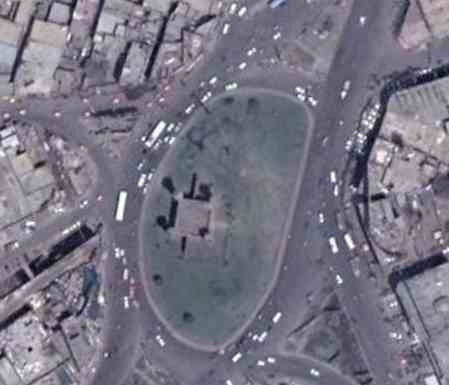


Chauburji


The Garden of Emperor's Daughter
Lahore is said to be the show-window of the Mogul architecture - no where in Pakistan are so many Mogul architectural infrastructure found as compared to Lahore. While landmarks in Lahore include the famous Badshahi Mosque, Shahi Qilla and Shalamar Bagh are very well known, there is one relic of Mogul architecture which has rather been obscured and less talked about when talking of Lahore and its heritage. This very different and unique structure has four minarets and a main entrance gate to once beautiful garden. For its typical four minarets, it is known as Chau (four) Burji (towers) or simply "Chauburji".
 Quite detached from the
main Mogul arena of the Badshahi Mosque and the Fort, Chauburji is
located some 3 kilometers southwards towards the main highway leading to
Multan. An inscription on the main gateway describes its year of
manufacture as 1646. The structure represents brilliant tile work mostly
turquoise colored with which the entire entrance is covered. It is a
masterpiece of architectural dexterity, and shows a dominant Persian
influence on sub-continental architecture. The entire building exhibits
a beautiful show of tiled floral panels. There is a great variety of
colors, but blue is predominant which has a cooling effect during
summer. The red brickwork is typical of the Muslim buildings of the
sub-continent; the doorways and windows running through the interior
corridors are exemplary of the living style that characterized the
Mughal buildings. However, the main purpose of building Chauburji
appears strictly to be monumental, as its presence in the heart of
Lahore signifies a strong sense of Mughal architectural beauty.
Quite detached from the
main Mogul arena of the Badshahi Mosque and the Fort, Chauburji is
located some 3 kilometers southwards towards the main highway leading to
Multan. An inscription on the main gateway describes its year of
manufacture as 1646. The structure represents brilliant tile work mostly
turquoise colored with which the entire entrance is covered. It is a
masterpiece of architectural dexterity, and shows a dominant Persian
influence on sub-continental architecture. The entire building exhibits
a beautiful show of tiled floral panels. There is a great variety of
colors, but blue is predominant which has a cooling effect during
summer. The red brickwork is typical of the Muslim buildings of the
sub-continent; the doorways and windows running through the interior
corridors are exemplary of the living style that characterized the
Mughal buildings. However, the main purpose of building Chauburji
appears strictly to be monumental, as its presence in the heart of
Lahore signifies a strong sense of Mughal architectural beauty.
 This
unique building is in fact the gateway to the garden of Zeb-un-Nisa
Begum, daughter of emperor Aurangzeb. This garden is believed to have been
extended from Nawankot in the south to the main city of Lahore towards north
- now no traces of such an expansive garden are now available. According to
REM Wheeler's book, 5000 Years of Pakistan, "The story goes that the garden
was laid out under the supervision of the princess' favorite female
attendant, Mian Bai; that it thus became known as Mian Bai's garden and was
on that account given to Mian Bai by (her) royal mistress." One of the
towers at the north-western corner once collapsed, its foundations perhaps
eroded by the waters of the flooding Ravi. However, after lot of neglect, it
was finally restored in 1960s as much as was reasonably possible and the
gateway now looks as it might have done during the time of its Mughal
patroness.
This
unique building is in fact the gateway to the garden of Zeb-un-Nisa
Begum, daughter of emperor Aurangzeb. This garden is believed to have been
extended from Nawankot in the south to the main city of Lahore towards north
- now no traces of such an expansive garden are now available. According to
REM Wheeler's book, 5000 Years of Pakistan, "The story goes that the garden
was laid out under the supervision of the princess' favorite female
attendant, Mian Bai; that it thus became known as Mian Bai's garden and was
on that account given to Mian Bai by (her) royal mistress." One of the
towers at the north-western corner once collapsed, its foundations perhaps
eroded by the waters of the flooding Ravi. However, after lot of neglect, it
was finally restored in 1960s as much as was reasonably possible and the
gateway now looks as it might have done during the time of its Mughal
patroness.

Aerial View (Courtesy Google Earth)
Chauburji was declared a protected monument under the Archaeological Act as revised in 1975. Though it has been repaired and somewhat protected, the signs of negligence are still present.
|
Copyright©JalalsPages - 2005 - 2007 |